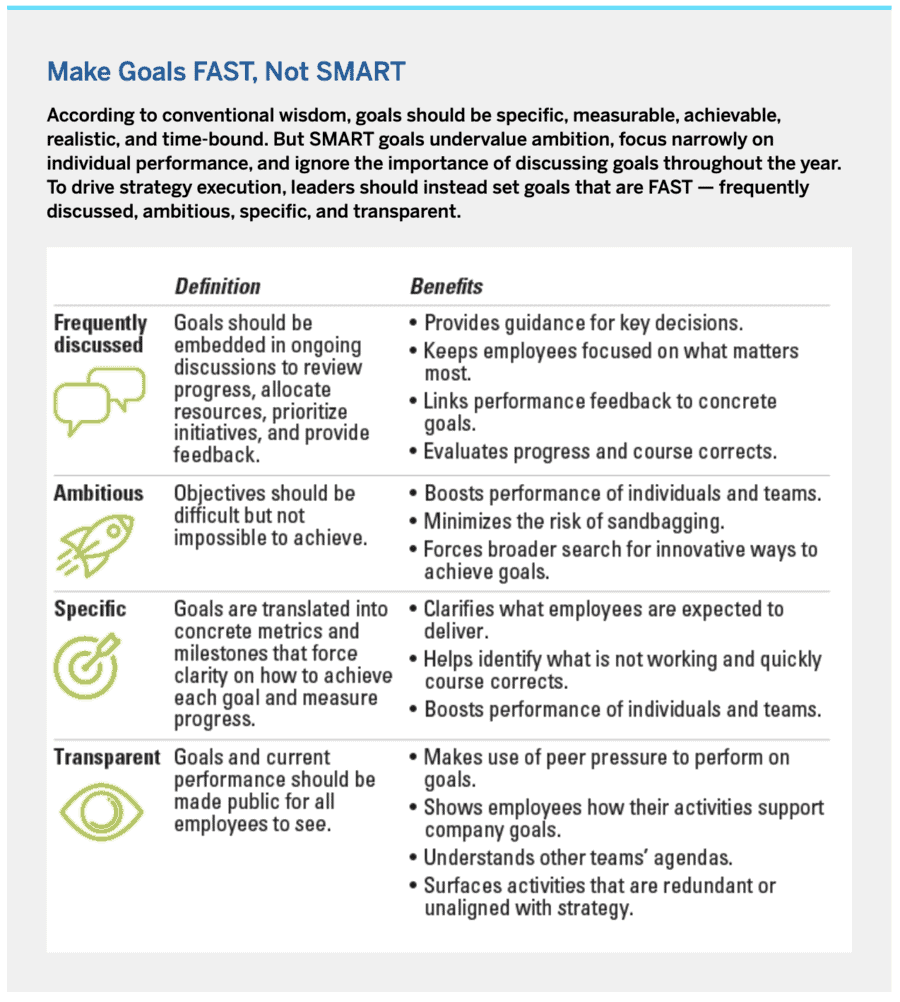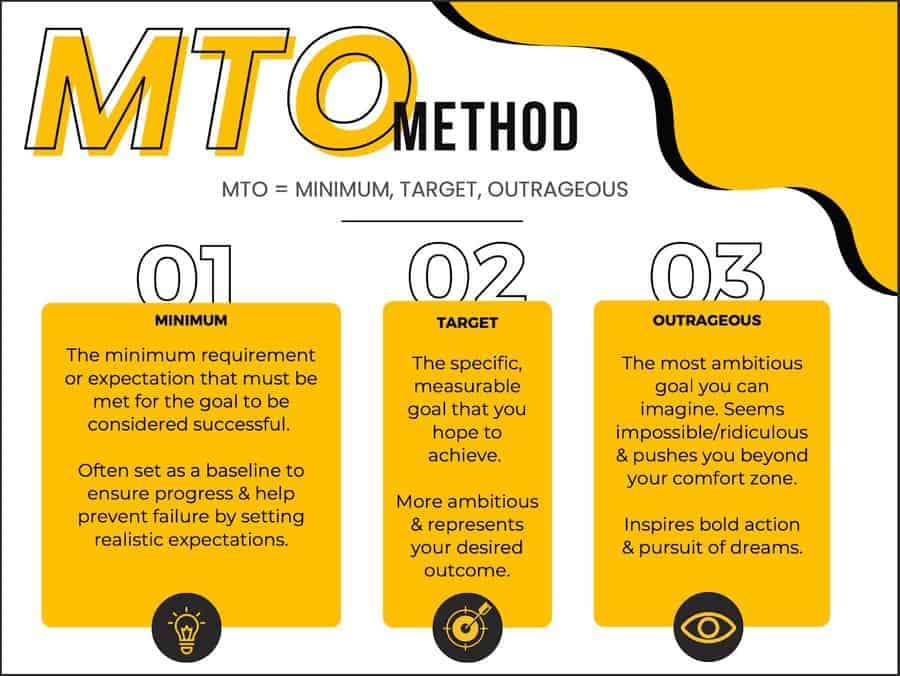How to Set SMART Sales Goals
Written by: Victoria Yu
Victoria Yu is a Business Writer with expertise in Business Organization, Marketing, and Sales, holding a Bachelor’s Degree in Business Administration from the University of California, Irvine’s Paul Merage School of Business.
Edited by: Sallie Middlebrook
Sallie, holding a Ph.D. from Walden University, is an experienced writing coach and editor with a background in marketing. She has served roles in corporate communications and taught at institutions like the University of Florida.
Updated on November 28, 2025

Setting goals is the crucial first step of a good strategy – in sales, mountain climbing, dieting, or just about any endeavor. Yet without an informed approach to achieving those goals, success is unlikely.
“Stop setting goals,” writes Stephen Covey, author of The 7 Habits of Highly Effective People. “Goals are pure fantasy unless you have a specific plan to achieve them.”
The message is clear. Logical goals and a plan of action provide direction and focus, enabling teams to prioritize and track progress. A great framework for this is the SMART approach, which stresses goals that are specific, measurable, achievable, relevant, and time-bound.
This guide explains the five elements of SMART, details how they sharply improve the chances of success, and provides examples to show how your business can leverage SMART to drive business growth.
What Are SMART Sales Goals?
In the beginning, SMART had nothing to do with sales.
In 1981, George T. Doran, a planning executive at a utility company, first laid out the SMART approach in an article for the Journal of Management Review titled “There’s a SMART Way to Write Management’s Goals and Objectives.”
Just two pages long, the article had a massive and lasting impact. Within a decade, many fields had embraced the SMART approach, not just management and sales, but also education, career development, and more.
SMART works because it provides a framework for setting and achieving goals that are clear, actionable, and aligned with vision and objectives.
| S | Specific |
| M | Measurable |
| A | Achievable |
| R | Relevant |
| T | Time-bound |
We mentioned them in the introduction, but this section examines each of the elements in detail. The SMART concept is about setting goals that are:
- Specific – Goals should be clear and well-defined. It should answer the questions of who, what, when, where, and why. For example, “Increase sales by 10% in the next quarter” is a specific goal.
- Measurable – Each goal can be quantified and evaluated. It has specific criteria to monitor, so you can gauge progress and know whether you’re headed in the right direction or have gotten off-track. For example, “Increase website traffic by 20% within the next month” is a measurable goal.
- Achievable – Every goal must be realistic and feasible, or the team risks wasting time tilting at windmills. It should be challenging, not impossible. “Add a million Instagram followers by next week,” for instance, is highly unlikely. But “Add 500 Instagram followers in the next month” could be totally doable.
- Relevant – The goal must be in line with broader objectives and priorities, rather than leading the team in another direction. Achieving the goal should be meaningful to those working toward it. For example, “Increase customer satisfaction by 10%” is relevant for a company that values customer service.
- Time-bound – The goal must have a deadline or clear end date to create a sense of urgency and ensure accountability. For example, “Increase our close rate by 15% by December 31st” is a time-bound goal.
In recent years, some businesses have shifted from SMART to SMARTER goals, adding two new elements to expand the concept. You should choose the best approach for you and your business.
- Evaluated – The goal should be monitored and regularly assessed to ensure progress and identify areas in need of improvement or adjustment.
- Reviewed – The goal should be periodically examined to ensure it remains relevant and aligned with broader objectives.
Why SMART Works for Sales
Taking the time to create a SMART roadmap for your team has significant benefits, including increased efficiency and productivity. Here are some advantages to SMART sales goals:
- Clarity – SMART goals provide a clear, concise understanding of exactly what is to be achieved, how, and by when. There’s no ambiguity or confusion, ensuring everyone is on the same page.
- Measurability – SMART goals are measurable and trackable, so it’s easier to identify potential roadblocks and take corrective action to avoid them.
- Focus – SMART goals provide clear direction and focus for sales teams, prioritizing work and resources to achieve desired outcomes.
- Motivation – SMART goals are challenging yet achievable and should motivate sales teams to work with a sense of urgency and purpose.
- Accountability – SMART goals ensure managers, reps, and teams are held accountable, as progress is constantly tracked and monitored.
Some businesses choose not to embrace SMART and instead set goals that are vague, difficult to monitor and not bound by a clear deadline. This often leads to serious pitfalls, including:
- wasted time and resources due to lack of direction
- procrastination, burnout, and lack of engagement
- an inability to identify what’s working and what’s not
- missed opportunity to increase sales and boost revenue
Bestselling author and motivational speaker Brendon Burchard argues that the opposite of SMART goals are DUMB goals:
- Difficult to achieve or define
- Unrealistic or unattainable
- Meaningless or not measurable
- Broad or vague
Setting DUMB goals often leads to frustration and failure, so it’s wise to embrace and implement the SMART framework.
How to Set SMART Sales Goals
Now that you know what’s SMART and what’s not, it’s time to start setting SMART goals for your business. Just follow these simple steps.
- Define objective – What exactly do you want to achieve? Do you want to increase revenue, add new customers, enter a new market? Clearly define your goal, keeping in mind the company’s objectives and overall strategy, target markets and competition, and other relevant information.
- Determine key performance indicators (KPIs) – Identify the metrics most relevant to your objective. If your goal is to increase website traffic, for instance, you might track website visits and conversion rates. Make sure the metrics you choose are clear and directly tied to your objective, and that the data is being tracked and recorded.
- Set specific targets for each KPI – Determine the baseline or starting point for each KPI, establishing a reference for your targets. For example, if your website receives 10,000 monthly visits, you might aim for a 25% increase and 2,500 more visits. Consider external factors that may impact the KPIs. For example, if your web traffic typically increases on holidays, you might adjust your target to account for those fluctuations.
- Identify the resources needed to succeed – Make a list of all the tasks required to achieve your sales goals, and all of the resources needed to complete each of those tasks. You might need market research, new leads, advanced tech tools, a bigger team, an improved sales script, product demonstrations, a better conversion rate, and more.
You may have all the resources you need in-house or you may need to acquire them externally. Allocate the required resources to each task based on priority.
- Assign roles and responsibilities to team members – Each team member or department should be made responsible for specific tasks or KPIs, with a timeline for reporting progress and making adjustments. You may want to reevaluate the skills and strengths of each team member to determine who is best suited for each task.
Assigning tasks based on experience and expertise ensures optimum efficiency. It’s also wise to set expectations for each task and role to make sure everyone understands their responsibilities.
- Establish a clear timeline – Rather than putting all your focus on the ultimate objective, it helps to set smaller interim goals. If your team aims to boost sales 40% this year, for instance, you could set a short-term goal of increasing sales 4% this month. This helps create a roadmap and keeps the team more focused on delivering every day. Create a series of smaller, achievable goals with deadlines for each.
- Monitor progress and adjust as needed – Don’t just track performance, take a closer look at it to find areas in need of improvement. Smart leaders analyze and leverage their KPIs.
Use sales dashboards and tools such as customer relationship management (CRM) software to track your progress in real-time, make projections and find trends and patterns. This should help identify areas in need of attention and inform your adjustments and adaptations. Maybe you’ll reallocate resources, alter your sales targets, or change your sales approach – it all depends on the data.
Check in regularly with team members and be willing to adjust roles and responsibilities as needed. If a team member is struggling, consider reassigning their task to someone better suited for the job.
It’s also wise to regularly review and adjust your SMART sales goals, such as on a quarterly or annual basis. This allows you to assess progress, identify challenges and obstacles, and make the changes that keep your team on track.
- Celebrate achievements – Celebrate even small wins along the way, as every achievement is meaningful. This boosts morale and motivation and keeps everyone engaged. Keep your team informed about progress and provide feedback, support, and encouragement to continue working toward the SMART goals.
3 SMART Sales Goal Examples
SMART sales goals aren’t just numbers. They’re powerful tools that can help you and your team stay motivated, focused, and accountable, as detailed in these examples below.
Whether you’re a seasoned professional or just starting out, these examples should increase your understanding of SMART sales goals and how to apply them.
Revenue
Basic Goal – Increase revenue
SMART Goal – Increase sales revenue 10% in the next quarter (Q2) by increasing outbound sales calls by 20% and improving our conversion rate from 20% to 25%
- Specific – The goal is clear and well-defined.
- Measurable – The goal highlights two KPIs: outbound sales calls and conversion rate.
- Achievable – The goal is based on market conditions, current products, recent sales, and the capabilities of the team, and should thus be achievable. A marketing campaign will run alongside this sales drive to increase brand awareness and generate more leads.
- Relevant – Increased sales revenue should mean increased profitability and growth.
- Time-bound – The goal sets a clear deadline, the end of Q2.
Closing Rate
Basic Goal – Improve closing rate.
SMART Goal – Improve our sales team’s closing rate by 15% by the end of the year, monitoring the share of successful sales calls and the number of closed deals.
- Specific – The goal is clear and well-defined.
- Measurable – The number of closed deals and the % of successful sales calls will be tracked and monitored in real-time by our CRM system.
- Achievable – The goal is achievable based on our sales team’s capabilities and previous performance. The company will add sales training on handling objections and communicating effectively, and will implement a robust lead-scoring system.
- Relevant – Improving the closing rate will mean increased revenue and profitability.
- Time-bound – The goal sets a clear deadline of the year-end.
Customer Retention
Basic Goal – Improve customer retention
SMART Goal – Increase our customer retention rate by 20% within the next six months by introducing a customer loyalty program and improving customer service.
- Specific – The goal is clear and well-defined.
- Measurable – Progress will be closely monitored by tracking customer purchasing data and feedback from surveys.
- Achievable – The goal is achievable based on product quality and competition. The company plans to implement a customer loyalty program with exclusive discounts and rewards for repeat customers. Customer service will work to reduce response times and more effectively resolve issues and complaints.
- Relevant – Better customer retention will mean greater customer lifetime values, a stronger brand reputation, and increased revenue and profitability.
- Time-bound –The goal includes a clear deadline, within six months.
Alternatives to SMART Sales Goals
The Problem with SMART Goals
SMART goals are often praised for their effectiveness, but some experts see them as outdated and problematic in today’s fast-paced business environment. Their concerns include:
- Lack of flexibility – The rigid SMART framework can make it difficult to adapt to unexpected events, changing circumstances, and other external factors. Goals that are too specific or narrowly defined are often resistant to alteration.
- Overemphasis on metrics – SMART’s focus on tracking progress puts too much emphasis on metrics and data that may not fully capture the complexity of a goal or its impact.
- Overemphasis on short-term – SMART goals emphasize specific, measurable objectives within a set timeframe. This can lead to a focus on short-term goals at the expense of more important, long-term objectives.
- Unintended consequences – Similarly, achieving some SMART goals may mean sacrificing key outcomes that were not fully considered in the goal-setting process.
- Unrealistic expectations – The SMART framework can create unrealistic expectations, particularly if the achievable criterion is interpreted too narrowly or if the goal is poorly aligned with available resources.
- Lack of motivation – Conversely, SMART’s emphasis on achievable goals could lead to goals that are too easy, undermining motivation and engagement.
- Inhibit creativity – Because SMART stresses clear and specific objectives, it may curb creativity, risk-taking, and innovation.
The SMART framework can help set goals, but it does have limitations. You could say its main advantage is also a disadvantage; the precision that makes SMART worthwhile can also be limiting in terms of scope, methods, and objectives. As a result, SMART goals should be used in conjunction with approaches that allow for greater flexibility and more creativity.
SMART Alternative #1 – FAST Goals
FAST is an acronym for frequently discussed, ambitious, specific, and transparent, and represents a goal-setting framework developed by the global consulting firm, Accenture. Like SMART, it aims to help businesses, teams, and individuals set more useful and effective goals.


With the FAST framework, businesses can improve focus and accountability, and better achieve their objectives.
SMART Alternative #2 – CLEAR Goals
CLEAR stands for collaborative, limited, emotional, appreciable, and refinable, and represents a goal-setting framework developed by Olympic Gold Medalist Adam Kreek of Values Drive Achievement. CLEAR is meant to keep pace with today’s faster, more agile business environment.
| Collaborative | Encourage team members to be involved and cooperate |
| Limited | Set limits, or boundaries, in terms of money, time, and scope |
| Emotional | Embrace emotions and passions to keep the team engaged and inspired |
| Appreciable | Break large goals down into smaller ones with measurable steps |
| Refinable | Be flexible and give permission to refine, adapt, and adjust as needed |
The CLEAR framework aims to create goals that can be embraced, enhanced, and executed by everyone on the team.
SMART Alternative #3 – MTO Goals
MTO is an acronym for minimum, target, and outrageous, and is a framework developed by leadership coach Raymond Aaron to escape what he describes as the dreaded binary of either achieving your goal and feeling good, or falling short of your goal and feeling bad.


The MTO framework is meant to provide a clear outline for success and enable businesses to balance realism and ambition.
Conclusion
The SMART approach can be a powerful tool, whether the goals are in sales, operations, productivity, or marketing. With specific, measurable, achievable, relevant, and time-bound goals, your team’s motivation, focus, and clarity should increase, along with your success rate.
But SMART cannot be all things to all organizations, and does sometimes fall short. So the wise move is to combine the SMART framework with strategies that provide greater space for adjustment, adaptation, and creativity.
Lastly, remember that setting SMART goals is just the first step. Achieving your objectives will likely also require consistent effort, determination, and resilience. But with the right approach and mindset, your business can achieve all its goals and reach its full potential.
FAQs
How do CRMs help track SMART sales goals?
CRMs allow for centralized data management, sales forecasting, activity tracking, and performance reporting. CRMs provide sales teams with tools to track sales goals, measure performance, and make data-driven decisions.
What’s the difference between an activity-based SMART goal and a results-based SMART goal?
Activity-based SMART goals help break down larger goals into smaller, more manageable tasks, and provide a clear roadmap for achieving your objectives. Instead of focusing on specific tasks, results-based SMART goals emphasize the result you’re aiming to achieve and measure progress toward that outcome.
How do I know if I set my SMART sales goals correctly?
The Harvard Business Review wrote “When 10%–20% of salespeople miss goals, the problem might be the salespeople. But when most salespeople miss, the problem is their goals.” If you’re not getting the results you want, it’s best to review and revise your goals appropriately.
How do I incentivize my SMART sales goals?
There are several ways to incentivize sales goals, including commission-based compensation, performance-based bonuses, recognition and rewards, gamification, and career advancement opportunities. Training and development help your team improve their skills and increase their chances of meeting sales goals. Ultimately, the key is understanding what motivates your team and tailoring your incentives accordingly.
